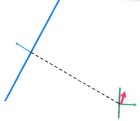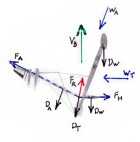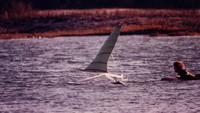High-Speed Sailing
| Vessel Name: | Sailien |
| Vessel Make/Model: | Experimental/custom |
28 September 2013
The America’s Cup
I watched, with interest, the videos of the 34th America’s Cup. At last we have fast sailboats engaged in a competition that is fun to watch. The virtual images (such as course boundaries, distance grid lines, separation between boats, etc.) overlaid on the real images really helps to keep the race [...]
31 August 2013
100 Knots for Hydroptere?
The latest news from Hydroptere is that they have plans for a 100 knot sailboat. This was posted on 26 Aug 2013, so look for that date at this address. http://hydroptere.com/en/the-news/last-news/
17 November 2012
Aptly named Sailrocket, blasts off!
While yet to be ratified, Sailrocket posted an average speed over 500 meters of 59 knots. I will not be surprised if they increase their record into the 60 knot range during this record attempt.
02 January 2012
More drag for VSR2?
I want to start by pointing out that the whole VSR2 team has done a stellar job and has demonstrated conclusively that the forces that drive a sailboat can be aligned for roll stability without using ballast and without using any down-force. (Trifoiler achieved roll stability by using down-force, but [...]
18 December 2011
My analysis of Sailrocket
I copied a diagram of VSR2 (wing doesn’t show well) and added in the major force arrows that apply. Be aware that these arrows are not correct in terms of scale (length) and some of their locations are guesses, however I believe I’m correct enough for us to learn something about what VSR2 has been [...]
23 October 2011
60 is within reach, what’s next?
I have been watching Sailrocket’s progress with great interest and there’s no question they have a winner. I fully expect to see them reach 60kt in the near future. Sailrocket has now demonstrated what I first learned with my models and again with my full-sized prototypes, that if you get the forces [...]
The real secret
I would like to point out that each view is correct to some degree. The real "secret" to more speed is the overall package and how each part contributes to the overall performance. As you know, I have primarily been saying that stability is the first priority (total control of pitch, roll, and yaw). Without that control, much of the rest of your efforts will be wasted, and I've been pointing out where these control weakness have proven to be a limiting factor to the current contenders.
While total control (stability) is the most basic fundamental, it is not the whole picture. You can have total control and not have a fast craft, and you can have an efficient craft that is fast but still limited by control problems (which is what we've been seeing). Note that I feel that the only advantage windsurfers and kite boarders have over other craft is their ability to sail in high wind situations.
I'm going to tell you a story to illustrate how the whole package is the most important element. About the time I got out of high school, I became quite interested in auto racing; unfortunately I didn't have much money so I couldn't afford to get a race car. My interest was sports cars and grand prix (Formula One) so I read the auto mags and went to sports car races. I had heard of oval track racing but knew nothing about it and never went to an oval track race. Some years later, I was hauling scrap iron (mostly junk cars) for a living and started working with a guy that had a stock car that he drove at the local track (1/4 mile dirt oval). I went to an oval track race for the first time and it looked like fun.
The result of watching that race was, I decided that I could build a car and would be able to run in the middle of the pack. I picked a modified class which had few rules restrictions on what I made. While I bought new steel tubing for the frame and roll cage, most of the rest of the parts were from the junk I was hauling. Because of my interest in grand prix, I built a mid engine, independent suspension car which was an unusual design for dirt track racing.
When I first drove out on the track, the announcer said "What's that, it looks like the cockroach that runs across my wall!" I went racing and as I learned how to drive and set up the car, I kept advancing in my class. The name Cockroach stuck and the fans got behind me because I kept going faster. I was only running junk, but I was beating cars that had much stronger engines and better tires than I did. (See my website for a picture of the car.)
How did I do it? I had a better overall package: Even though I had less engine power, I made up for it by building a lighter car, even though I couldn't afford the best tires, I made up for it by building a better suspension and a better balanced car. In motor racing the power to weight ratio is more important than the power of the engine, the total traction (tires, suspension and weight balance) is more important than the traction of the tires alone. (Note that Greenbird on ice had a problem due to rough ice, but did not have a similar problem with tires on land. I suspect that suspension for the ice boat may be the key.)
Ok, so how does this relate to going fast in a sailboat? Well take a look at what's going on out there. The windsurfers and kite boarders are the least efficient of the top contenders and yet they have dominated. They have done it by being able to sail in stronger winds than any other contender, which means they have better control under those conditions. Check out the interview with Simon McKeon of Macquarie Innovation in which he says control is key.
http://www.yachtingworld.com/auto/newsdesk/20090401110723ywperformance.html
Note that Yellow Pages held the record for eleven years because of their efficiency; the windsurfers and kite boarders then took the record because of better control in strong winds but now Innovation is close, due to efficiency again.
If someone can combine best control with best efficiency (best overall package), the speed record will jump to a higher range. Once again I want to state that I know how to do this and I'm looking for commercial or racing interest to pursue this.
Bob
About & Links
- Bob's Surfing Blog
- Bob's Website
- Greenbird (Windjet)
- l'Hydroptere
- Le Projet Dared
- Macquarie Speed Sailing Team
- Monofoil Sailing
- Mountain Goat STOL
- Mr Smith's Amazing Sailboats
- Patent Office (Search)
- Radboat
- Sailien Prototypes (early), Delta, etc.
- Sailien Video
- Sailien Website
- The Basics of Surfboard Design
- The Basics of Surfboard Design en Espanol
- The Swedish Speed-Sailing Challenge
- Trifoiler
- Vestas Sailrocket
- Windjet Project
- WSSRC


